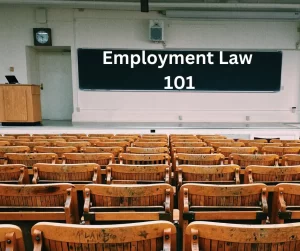
Under Washington State Court Rules, how may litigators utilize WA State Rule of Civil Procedure CR 16 (Pretrial Procedure and Formulating Issues)? Here’s my point of view.
IMPORTANT: All hyperlinks in this article with an asterisk (*) will take the reader away from this website to either our Williams Law Group Blog* or an official governmental website. This article is for informational purposes only and is based upon my point of view. Due to the rapidly changing nature of the law, we make no warranty or guarantee concerning the accuracy or reliability of the content in this article. No content on this site, regardless of date, should ever be used as a substitute for direct legal advice from your attorney. Please review our Disclaimer|Terms of Use|Privacy Policy before proceeding.
WA State Rule of Civil Procedure CR 16: A Guide for Litigators
In the legal arena, rules and procedures govern every aspect of a case, ensuring fairness and efficiency in the pursuit of justice. Washington State Rule of Civil Procedure CR 16* is one such crucial guideline that sets the stage for the orderly progression of civil litigation. Understanding CR 16 is essential for attorneys and litigants alike to navigate the complexities of the legal process in Washington State courts effectively.
What is CR 16?
CR 16, short for Washington State Rule of Civil Procedure 16, outlines the requirements and procedures for pretrial conferences and the development of a litigation plan. It serves as a roadmap for streamlining the litigation process, promoting early settlement, and ensuring that cases proceed expeditiously through the court system. The court rule states as follows:
CR 16
PRETRIAL PROCEDURE AND FORMULATING ISSUES
(a) Hearing Matters Considered. By order, or on the motion of any party, the court may in its discretion direct the attorneys for the parties to appear before it for a conference to consider:
(1) The simplification of the issues;
(2) The necessity or desirability of amendments to the pleadings;
(3) The possibility of obtaining admissions of fact and of documents which will avoid unnecessary proof;
(4) The limitation of the number of expert witnesses;
(5) Such other matters as may aid in the disposition of the action.
(b) Pretrial Order. The court shall make an order which recites the action taken at the conference, the amendments allowed to the pleadings, and the agreements made by the parties as to any of the matters considered, and which limits the issues for trial to those not disposed of by admissions or agreements of counsel; and such order when entered controls the subsequent course of the action, unless modified at the trial to prevent manifest injustice. The court in its discretion may establish by rule a pretrial calendar on which actions may be placed for consideration as above provided and may either confine the calendar to jury actions or to nonjury actions or extend it to all actions.
CR 16* (emphasis and hyperlink added).
Key Components of CR 16
1. Pretrial Conferences: CR 16 allows–by order, or on the motion of any party–pretrial conferences to facilitate communication between parties and the court during the litigation process. These conferences aim to identify and narrow the issues in dispute, explore opportunities for settlement, and establish a framework for the efficient resolution of the case.
2. Litigation Plan: One of the central features of CR 16 is the formulation of a litigation plan. This plan outlines the parties’ proposed course of action, including simplifying the issues, amendments to the pleadings, the possibility of obtaining admissions of fact and of documents, limiting the number of expert witnesses, and any other pertinent matters essential for the progression of the case. The litigation plan helps parties and the court manage expectations and timelines effectively.
3. Pretrial Orders: The court must issue an order documenting the proceedings of the conference, including any amendments permitted to the pleadings and agreements reached by the parties on relevant matters. The order must delineate the issues remaining for trial, excluding those resolved through admissions or agreements of counsel. Once entered, this order governs the subsequent progression of the case unless modified during the trial to prevent clear injustice. Additionally, the court, at its discretion, may institute a pretrial calendar system for cases to undergo similar consideration. This calendar may be limited to either jury or nonjury cases, or expanded to encompass all types of actions.
Benefits of CR 16
1. Efficiency: By promoting early communication and establishing clear guidelines for case management, CR 16 helps expedite the litigation process, reducing delays and unnecessary expenses for all parties involved.
2. Clarity and Predictability: The requirement to develop a litigation plan provides clarity and predictability regarding the progression of the case, enabling parties to allocate resources more effectively and plan their litigation strategies accordingly.
3. Encouragement of Settlement: Through pretrial conferences and the exploration of settlement options, CR 16 encourages parties to resolve their disputes outside of court, potentially saving time, money, and emotional energy associated with protracted litigation.
4. Judicial Oversight: By empowering the court to actively manage the case through case management orders, CR 16 ensures that proceedings are conducted in a fair and orderly manner, with judicial oversight to address any procedural issues that may arise.
Conclusion
Washington State Rule of Civil Procedure CR 16 plays a vital role in promoting efficiency, fairness, and effective case management in civil litigation. By allowing pretrial conferences, formulating litigation plans, and providing for judicial oversight, CR 16 helps streamline the litigation process and facilitates the early resolution of disputes. Attorneys and litigants should familiarize themselves with CR 16’s requirements to navigate the complexities of civil litigation in Washington State courts successfully.
LEARN MORE
If you would like to learn more, then consider contacting an experienced attorney to discuss your case. This article is not offered as legal advice and will not establish an attorney-client relationship with Law Office of Gregory A. Williams, or the author of this article; please refer to our Disclaimer | Terms of Use | Privacy Policy for more information.





























